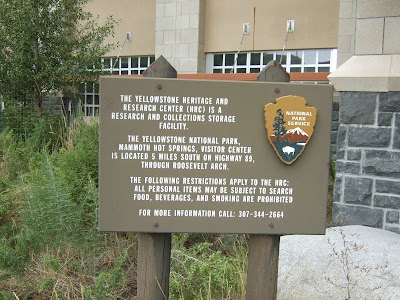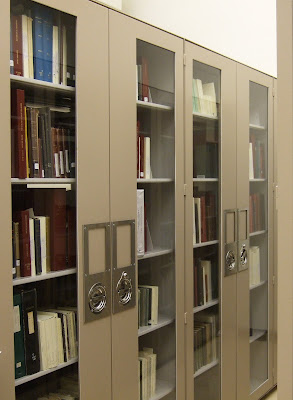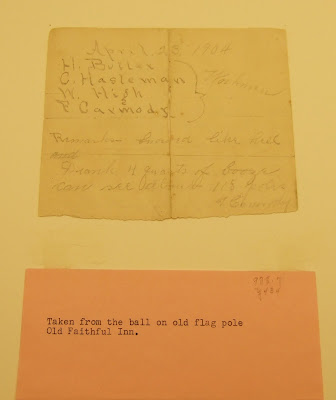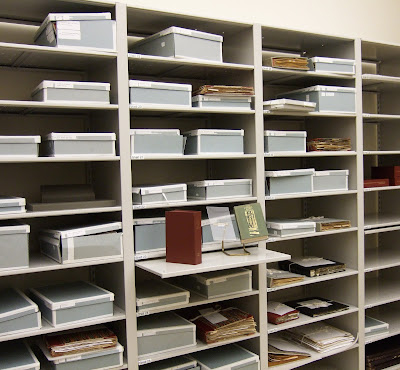 |
| From September 2010 |
Last week, Anne Foster (the archivist from Yellowstone National Park) asked me to let job seekers know that three new archivist positions had been posted at USAJobs. Because a few of you readers might just apply for one of these great opportunities, I thought I'd share my experience touring the Yellowstone Heritage and Research Center where the archives live and the parks' museum collections are stored.
 |
| From September 2010 |
The very large, very clean, friendly building was built in 2004 because the park needed more space for its archival and museum holdings. As far as the archives go, there are three collections: natural resources, donated materials, and scheduled records. The administrative records for the world's first national park (some shown above) include some pretty interesting records, especially the work journals of military personnel who ran the park in the early days.
 |
| From September 2010 |
Although the park is affiliated with the National Archives and Records Administration (NARA), records "born" at Yellowstone remain there instead of being sent off to NARA. It makes sense because if you are already at Yellowstone researching a given topic, such as the park's wolf population, it could be cost/time prohibitive to travel to NARA for records or pay for them to be digitized.
 |
| From September 2010 |
(There's Anne above, giving a tour of the big map room.) John and I were lucky enough to experience two tours, a private one with only Anne, and a public one shared with about 10 tourists. Prior to the public tour, I had the opportunity to ask Anne a bit about the collections. She told us that she was only a few months into the job (had come from the University of Alaska) and already had plans to do a lot of weeding, research into provenance, and much more work. That's when I first learned she would be hiring a few archivists to help.
 |
| From September 2010 |
The public tour started in the rare books room. Not only were there rare books but the park has scrapbooks and clippings ranging from 1914 through the 1940s. There we saw an exhibit of a note found at the top of a flag pole that showed the names of some of the workers.
 |
| From September 2010 |
There were signed copies of rare books, including the first book published in the Montana territories, "Vigilantes of Montana."
 |
| From September 2010 |
From the rare books room, we returned to the archives in the public tour, where we learned more about the content of the materials.
 |
| From September 2010 |
Early on, the military hired civilian scouts. Researchers can see their diaries. They can also see how park workers' attitudes toward the animal inhabitants changed over time. In the early days, the animals were referred to as "pets."
 |
| From September 2010 |
Here Anne is showing the important wolf migration maps. She also mentioned the documentation of elk overgrazing that can be shown in the elk movement maps. As an archivist very interested in advocacy, I was inspired by how Anne showed through the materials that archives help people understand how visitors experience wilderness over time.
 |
| From September 2010 |
After the archives tour, we were treated to a fun tour of the museum's storage area by registrar Bridgette Guild. There we learned that the photographs are kept in the museum storage area, not upstairs in the archives. Ken Burns used 900 images from the collection in his PBS miniseries on the national parks.
 |
| From September 2010 |
Among the museum's more than 300,000 items, they hold approximately 10,000 specimens, including 96 wolf skulls. Some of the items on the table are from the archeology collection. Researchers who take samples during their surveys of the park are required to submit samples to the museum.
The gun on the table is called a "Thumper Gun" made by Smith and Wesson. They originally used liquid slugs to break up riots. Now they are used with rubber bullets to deter bears.
In another part of the storage area are the Thomas Moran watercolors. They are kept in special cabinets to prevent as much deterioration as possible. Although they do get out, to protect them, the works are not loaned out on any long-term basis.
Overall, the Yellowstone National Park Heritage and Research Center (which also includes a lovely research library, by the way), is a stop that should not be missed on your next visit to Yellowstone. Best of luck to the candidates who apply for the prize archivist positions.